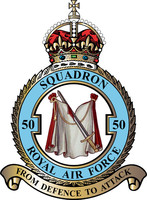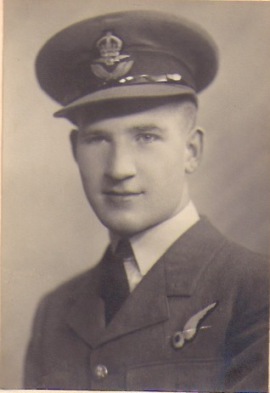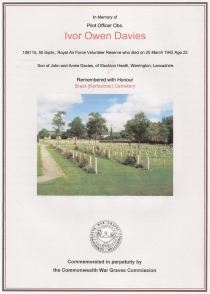Pilot Officer Ivor Owen Davies
Ivor was born in Houghton-le -Spring, Durham on 7th February 1920. His father, John was from Pembrokeshire, and his mother Anne was from Houghton.
Ivor was destined to work in the "family business" of department stores, and was a management trainee. He was an accomplished pianist, amateur dramatist, and had a passion for photography, developing all his photos himself.
He undertook some of his Observer training in Hamilton Ontario, which must have run in the family as his brother, William was an Observer with 827 Sqdn. Fleet Air Arm, flying Albacores.
He was posted from 25 OTU on 30th December 1941, but did not fly on operations until February 1942.
His operations being;
17/2/42, Nickelling,
Cherbourg,
AE423.
25/2/42, Gardening,
P1239.
27/2/42, Gardening,
P1239.
13/3/42, Cologne,
AE388.
24/3/42, Gardening,
AE429.
The aircraft took off from Skellingthorpe on Mining activities (Gardening)
Their Aircraft was Hampden AE429 VN-?
The Crew being P/O D R Fair
P/O I O Davies
Sgt J Hudson
Sgt J H Pearson
Chorley states; T/o Skellingthorpe for mining activities in the Artichokes area. Presumed crashed in the vicinity of Brest, where the crew are buried in Kerfautras Cemetery.
Loss of Hampden bomber piloted by P/O R. Fair at Morlaize, Finisterre on 25th March 1942.
The following are the facts regarding the crash ascertained by Mr. H.R Fair (the father of the pilot) during a visit to Tremel, near Morlaize in August 1947.
M. Francis le Noan who resides on the river bank at Dourduff en Mer, Plouezoch, Finisterre, the scene of the crash gave the following account.
The plane came from the direction of Loriend at about 2am on the 25th March 1942. It was a very dark night and the tide was up. The plane was evidently in difficulties and did not appear capable of crossing to England. The pilot may have been endeavouring to land in the estuary. As it approached it was hit by an A.A battery on the hill behind Plouezoch on the right bank. Part of the tail was found near the village. The plane crashed into the sea at the mouth of the river where the estuary is about a half mile wide it exploded as it hit the water.... probably the petrol tanks exploded. The plane now lies in the channel and is visible at low tide. The crew were either blown out of the plane or may, except the pilot have clambered outside the plane – all appear to have been killed instantly. P/O Davies’ cap was found 10 miles away. The Germans sent out a small boat in search of survivors. This boat found the bodies of Sgt’s. Pearson and Hudson floating in the water at about 4am. They were taken to Loquenole where a German force was encamped. Four days later 29th March - M. le Noan found the body of P/O Davies in the estuary and took it ashore in the grounds of the chateau owned by Madame de Beauregard at Plouezoch. Before the arrival of the Germans he examined his pocket book and from his identity card learned his name and from a ration book issued in Torquay assumed he had flown from there. He had to hand the pocket book over to the Germans but managed to secrete a letter and two photographs, one of himself and another of a young lady. In July 1944 M. le Noan handed these over to the Captain of a British minesweeper in Brest, together with a letter giving particulars of the crash, asking the Captain to send them to Torquay. He has never had a reply.
Mde. De Beauregard was present when. P/O Davies was brought ashore and said a prayer beside him. The German Officer who took charge saluted the body very respectfully and had it taken to the village of Plouezoch where it was placed in a coffin and taken to Loquenole where the other bodies were lying. On the same day the Germans from the battery that had shot the plane down went out in a boat of a neighbour of M. le Noan and recovered the body of P/O Fair from the cockpit of the plane. He was in his dark blue battledress .without any apparent injury, his face was quite calm and his cap was still on. It would appear that he must have been killed instantly whilst still at the controls. His body was taken over to the left bank and taken to Loquenole and placed in a coffin, Next day 30th March all four were taken to Brest and buried in the Kerfautras cemetery.
Visit to the cemetery at Brest.
26th August 1947. Pastor A. Sornerville of the Baptist Church in Morlaize took Mr Fair, his brother and a Miss A Andrews in his car to Brest. The graves were found about the middle of Plot 46. They are in a group amongst the graves of French soldiers of the 1914-18 war. Beside these are the graves of the crew of a bomber which crashed near Morlaize at an earlier date. The graves bear a wooden cross erected by the Germans and a white painted temporary cross erected by the War Graves Identification Service, Each cross with name, regimental number and date in block letters. Our men's graves have not yet been taken over, they are just slight mounds of loose earth- but quite neat and tidy and tree of weeds and grass. They show evidence of loving sympathy as they have been planted with rosemary, carnations and polyanthus. A low box edging, similar to that edging of the French war graves has been planted around P/O Davies grave. As it was learned from the caretaker that our men had been buried without any religious service. Pastor Somerville, who speaks English conducted a brief burial service of prayer and scripture readings and also read the hymn “These things shall be a loftier race” and then concluded with the committal sentences and the benediction. Large bunches of flowers were placed on each grave on behalf of the relatives bearing the inscription "affectionate remembrance from his loved ones.”
Mr. Fair is indebted to M. le Pasteur A Somerville and M. Le Noan of Le Dourduff en Mer, Plouezoch, Morlaize who came out 10 miles to Tremel to tell all he knew. In the case of a previous crash near Morlaize preparations were made by the inhabitants to afford the crew an imposing funeral and quantities of flowers were sent. At the last moment the Germans stopped the funeral and sent the bodies to Brest for burial. It was no doubt, to prevent a similar demonstration of sympathy that our relatives were sent to Brest.
SUPPLEMENT Letter dated 23Td Sept 1947 received by Mr. Fair from M, Jean Tougruy (?) enclosing photographs of the wrecked plane, EXTRACT- I took photographs from a boat. The plane is entirely destroyed and we barely recognised the wrecks of motors, wings and cockpit sunk in the mud. When I got back to the little village of Locquenole I talked with the fisherman who hired me his boat and with another. So I heard some news of your son's plane. These two men were fishing in the narrow channel when they suddenly heard the noise made by the “flak” of Locquenole. A little moment after they saw a bomber in flames, which fell in the mud. They quickly went towards the fallen plane to try to save the crew if they were still alive. German sailors came quickly too and fired on the fishermen who went back to the harbour and told the people about it. A great number of fishermen, their wives and children came then to the main road staying and looking at what the Germans were doing, The Germans carried two bodies which they put down at the roadside, immediately French people sent flowers and began to carry the bodies towards the village church, but the Germans came back again soon after, took the bodies, put them in a handcart and went to another village (Taule) 4 miles from Locquenole, followed by a great number of French people. The bodies were buried there, but some days after, seeing that the French people had put flowers, English and French flags arrested some hostages who were liberated soon after. They disinterred the two bodies and carried them to the cemetery Kerfautras at Brest. I was awfully pained listening to these words and thinking of your son and his fellows who fell in this mud of Locquenole and who fought tor our liberation.





